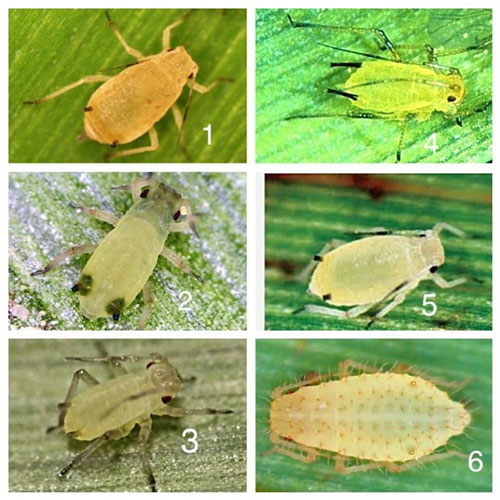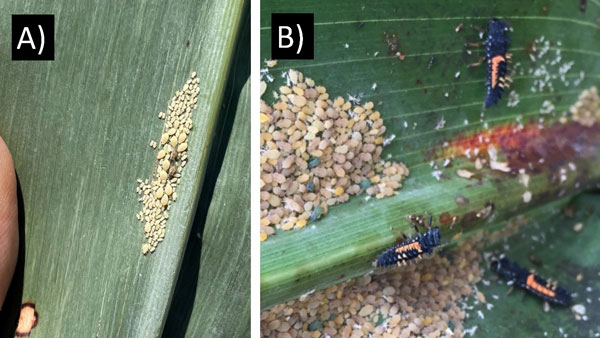Sorghum (formerly sugarcane) aphids continue to decline as a threat to grain sorghum in Kansas. Although late-planted sorghum remains at higher risk of colonization, region-wide biological control is now effectively maintaining populations below the economic threshold in the vast majority of fields, regardless of planting date, and reducing the number of migrant aphids arriving.
Thorough field scouting may reveal a few small 'nuclear' colonies on lower leaf surfaces and perhaps the occasional larger, established colony, but infestations heavy enough to require treatment remain rare and most likely caused by imprudent insecticide applications targeting other pests.
Identification of sorghum aphid
Several aphid species on sorghum could be confused with sorghum aphids, especially when the aphids are small. The sorghum aphid has a smooth body with a light-colored head and light-colored legs with dark feet. They have very short, cornicles (tail pipes) with no shading at the base of them, as on the corn leaf aphid. Corn leaf aphids are blue-green at cooler temperatures but can be pale to yellowish green in hot weather. However, in both cases, they have dark patches around the base of the cornicles and a more rectangular body.

1. sorghum aphid
2. corn leaf aphid nymph
3. corn leaf aphid nymph
4. English grain aphid (note long cornicles, antennae longer than the body)
5. sorghum aphid
6. yellow sugarcane aphid (note bristles on body)
Scouting for sorghum aphid
Early detection is key to managing this pest, but treatments should be based on established thresholds. The aphids tend to be distributed in patches, and a few heavily infested plants will not cause yield loss. Applying insecticides too soon can disrupt biocontrol that would otherwise control the aphids and create a need for repeated applications.
Plants are vulnerable to infestation by SCA at any growth stage, but Kansas sorghum is most at risk from boot stage onward. The ability of sugarcane aphids to overwinter on Johnsongrass and re-sprouted sorghum stubble represents challenges to the management of this pest in more southerly regions.
Issues arising from sorghum aphid in Kansas are likely to become increasingly uncommon with each passing year, as biological control by natural enemies like lady beetles (Fig. 1B) and lacewings usually provide adequate control during early establishment of aphid colonies (Fig. 1A). It is best practice to scout late-planted fields, as these are more susceptible to yield loss as they afford the aphids a bigger window to build to damaging levels late in the season. Also, prioritize fields that were planted to susceptible varieties. Be sure to contact your seed dealer for information on hybrid tolerance to sorghum aphids.

Figure 1. A) Newly established aphid colonies, and B) one of many natural enemies, larvae of the lady beetle Harmonia axyridis, feeding on aphid colonies.
Sampling method
- Once a week, walk 25 feet into the field and examine plants along 50 feet of row:
- If honeydew is present, look for SCA on the underside of a leaf above the honeydew.
- Inspect the underside of leaves from the upper and lower canopy from 15–20 plants per location.
- Sample each side of the field and sites near Johnsongrass and tall mutant plants.
- Check at least 4 locations per field for a total 4 locations per field for a total of 60-80 plants.
If no aphids are present, or only a few wingless/winged aphids are on upper leaves, repeat this sampling method once a week.
If sorghum aphids are found on lower or mid-canopy leaves, begin scouting twice a week. Use the same sampling method, but be sure to include % plants with honeydew. Estimate the % of infested plants with large amounts of sorghum aphid honeydew (shiny, sticky substance on leaf surface) to help time foliar insecticides for sorghum aphid control on sorghum (Table 1).
Table 1. SCA Thresholds
|
Growth Stage |
Threshold |
|
Pre-Boot |
20% plants infested with localized area of heavy honeydew and established aphid colonies |
|
Boot |
20% plants infested with localized area of heavy honeydew and established aphid colonies |
|
Soft dough |
30% plants infested with localized area of heavy honeydew and established aphid colonies |
|
Dough |
30% plants infested with localized area of heavy honeydew and established aphid colonies |
|
Black Layer |
Heavy honeydew and established aphid colonies in head *only treat to prevent harvest problems **observe pre-harvest intervals |
A free sorghum aphid scouting guide is available to download here: https://www.myfields.info/sites/default/files/page/ScoutCard%20KSU%20v05312017.pdf
Brian McCornack, Entomologist
mccornac@ksu.edu
Anthony Zukoff, Extension Associate, Southwest Research-Extension Center
anzukoff@ksu.edu
J.P. Michaud, Entomologist, Agricultural Research Center-Hays
jpmi@ksu.edu
Jeff Whitworth, Entomologist
jwhitwor@ksu.edu